Vintage Hall’s Superior Quality Kitchenware bowl (Tested and approved by Mary Dunbar, Jewel Homemaker’s Institute). 9,100 ppm Lead. Click to see the bowl!
Posted: Friday, March 20, 2020
Introduction: Tamara Rubin is an independent advocate for consumer goods safety, and she is also a mother of Lead-poisoned children. She began testing consumer goods for toxicants in 2009 and was the parent-advocate responsible for finding Lead in the popular fidget spinner toys in 2017. She uses high-precision XRF testing (a scientific method used by the Consumer Product Safety Commission) to test consumer goods for metallic contaminants – including Lead, Cadmium, Mercury and Arsenic.
Vintage Hall’s Superior Quality Kitchenware bowl:
The full XRF test results of the bowl pictured are below (so please scroll down). Here are links to some additional reading that may be of interest, based on your interest in the test results of this item:
- Click here to see more vintage dishes I have tested.
- Click here to see more dishes with Lead that I have tested.
Stay Safe Out There!
A quick note from Tamara
Hey readers – I hope you are staying well out there with all that is going on in the world right now. I’m hanging out mostly at home with my children – and have been doing so for about 10 days now. I pulled them out of school over a week ago – just to be safe. Each of my three youngest sons have compromised immune systems (which manifests in different ways for each of them), due to having been Lead-poisoned as babies.
In between kid-wrangling I am working hard to publish literally HUNDREDS of new posts (with test results for various consumer goods I have tested over the past couple of years, but have not yet had a moment to report on!). These posts have created a backlog in my system for more than a year now – and it’s actually nice to have a *break* with some time to catch up! To make this happen as quickly as possible, I am (as with this post) simply posting the images and the test results – without a lot of additional information. [Do not worry — I will continue to update them with more information as I get caught up and begin to have the time!]
For those new to my website, please check out the menu in the header of the website for more information about how I test things (and my background, etc.) On each post you can also click on any of the keyword tabs at the top of the post to find more items in that category. Here’s the post discussing the type of testing I do, and the specific instrument I use to detect, analyze and confirm metals content, and ultimately produce the resultant data for each item reported here – link.
Please Note: Test results reported below are science-based, accurate, and replicable. Test results reported here are from tests that were done for a minimum of 60 seconds each, and repeated multiple times, to confirm the results. As with all the testing reported here on my blog, a freshly-calibrated high-precision XRF instrument testing in Consumer Goods mode was used to test the item pictured here.
As always, please let me know if you have any questions.
Thank you for reading and for sharing my posts!
Tamara Rubin
#LeadSafeMama
Test results for the vintage Hall’s Superior Quality Kitchenware bowl pictured on this post:
Food surface of bowl (center of bowl):
- Lead (Pb): 112 +/- 42 ppm
- Barium (Ba): 4,830 +/- 725 ppm
- Tin (Sn): 1,653 +/- 132 ppm
- Iron (Fe): 1,616 +/- 287 ppm
- Bismuth (Bi): 111 +/- 43 ppm
- Titanium (Ti): 3,307 +/- 240 ppm
Decorative exterior of bowl – on red flower:
- Lead (Pb): 9,100 +/- 430 ppm
- Arsenic (As): 1,218 +/- 205 ppm
- Barium (Ba): 2,883 +/- 494 ppm
- Antimony (Sb): 196 +/- 96 ppm
- Tin (Sn): 1,751 +/- 116 ppm
- Zinc (Zn): 846 +/- 94 ppm
- Iron (Fe): 3,500 +/- 310 ppm
- Titanium (Ti): 1,281 +/- 126 ppm
- Chlorine (Cl): 13,700 +/- 1,400 ppm
Bottom of bowl – on gold logo:
- Lead (Pb): 71 +/- 26 ppm
- Barium (Ba): 3,953 +/- 501 ppm
- Tin (Sn): 1,486 +/- 91 ppm
- Gold (Au): 199 +/- 45 ppm
- Copper (Cu): 116 +/- 59 ppm
- Iron (Fe): 1,271 +/- 185 ppm
- Bismuth (Bi): 124 +/- 31 ppm
- Titanium (Ti): 3,213 +/- 216 ppm
~ End of Post ~
Scroll down for additional photos of this item.


Never Miss an Important Article Again!
Join our Email List


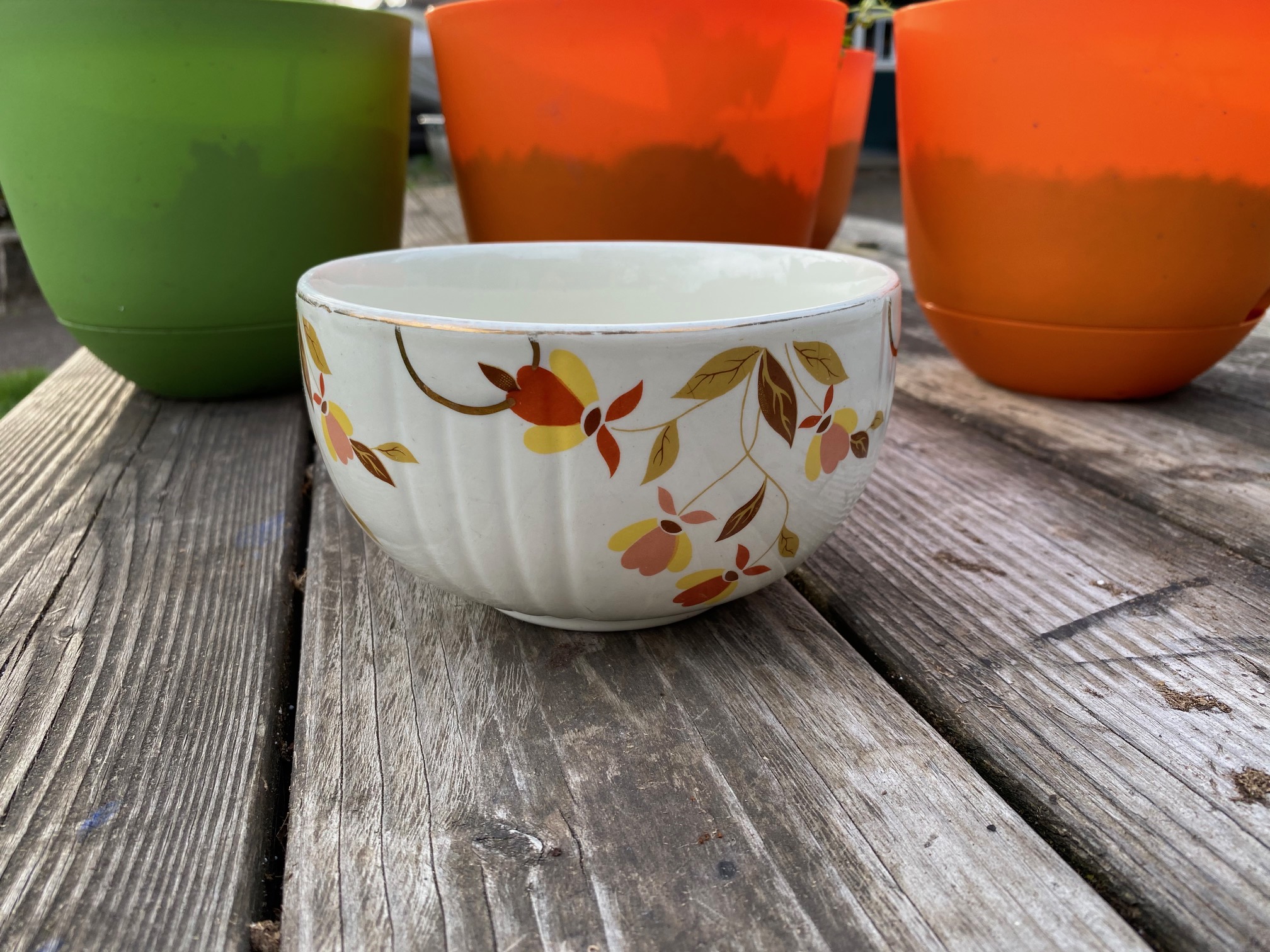
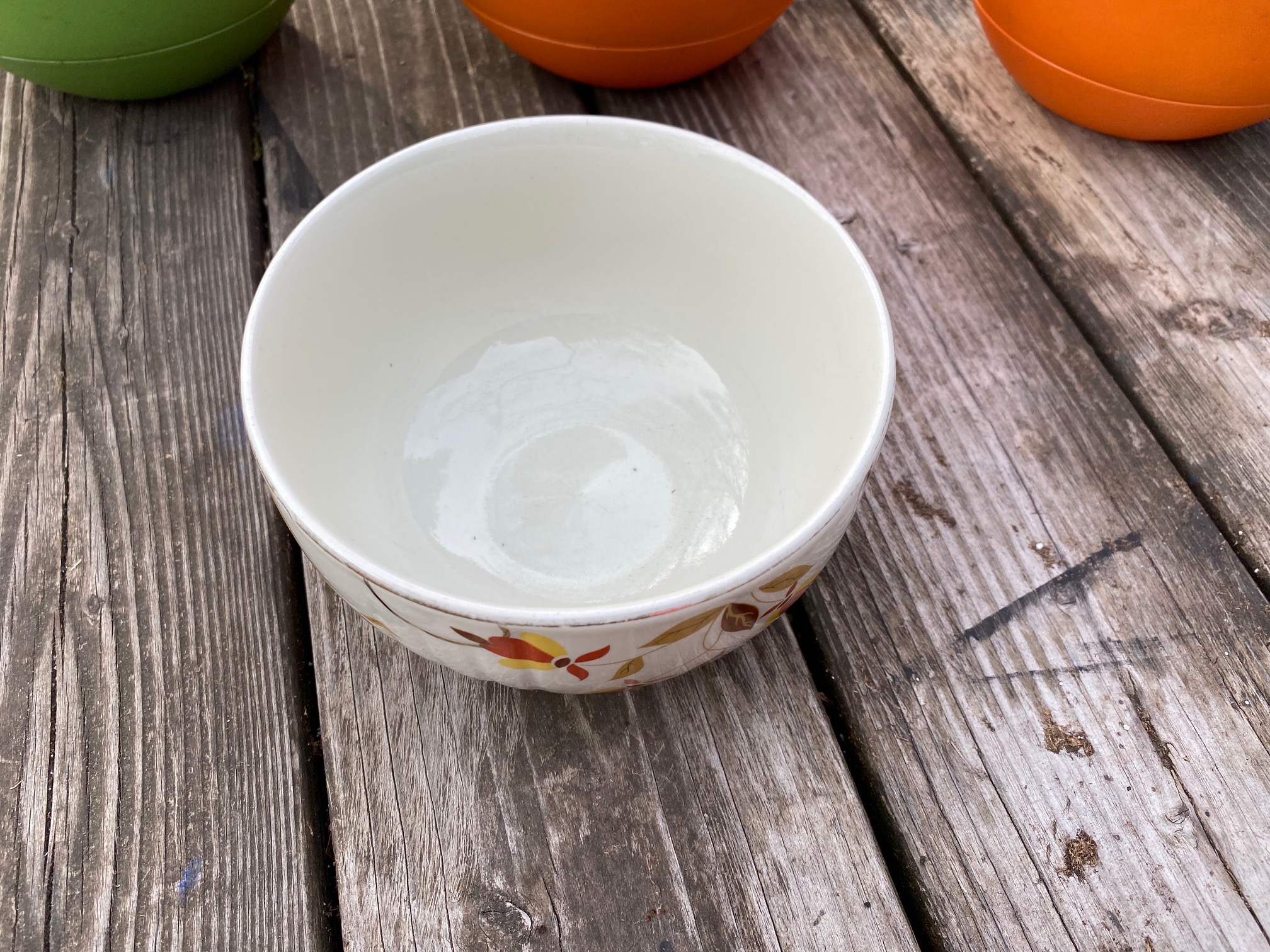
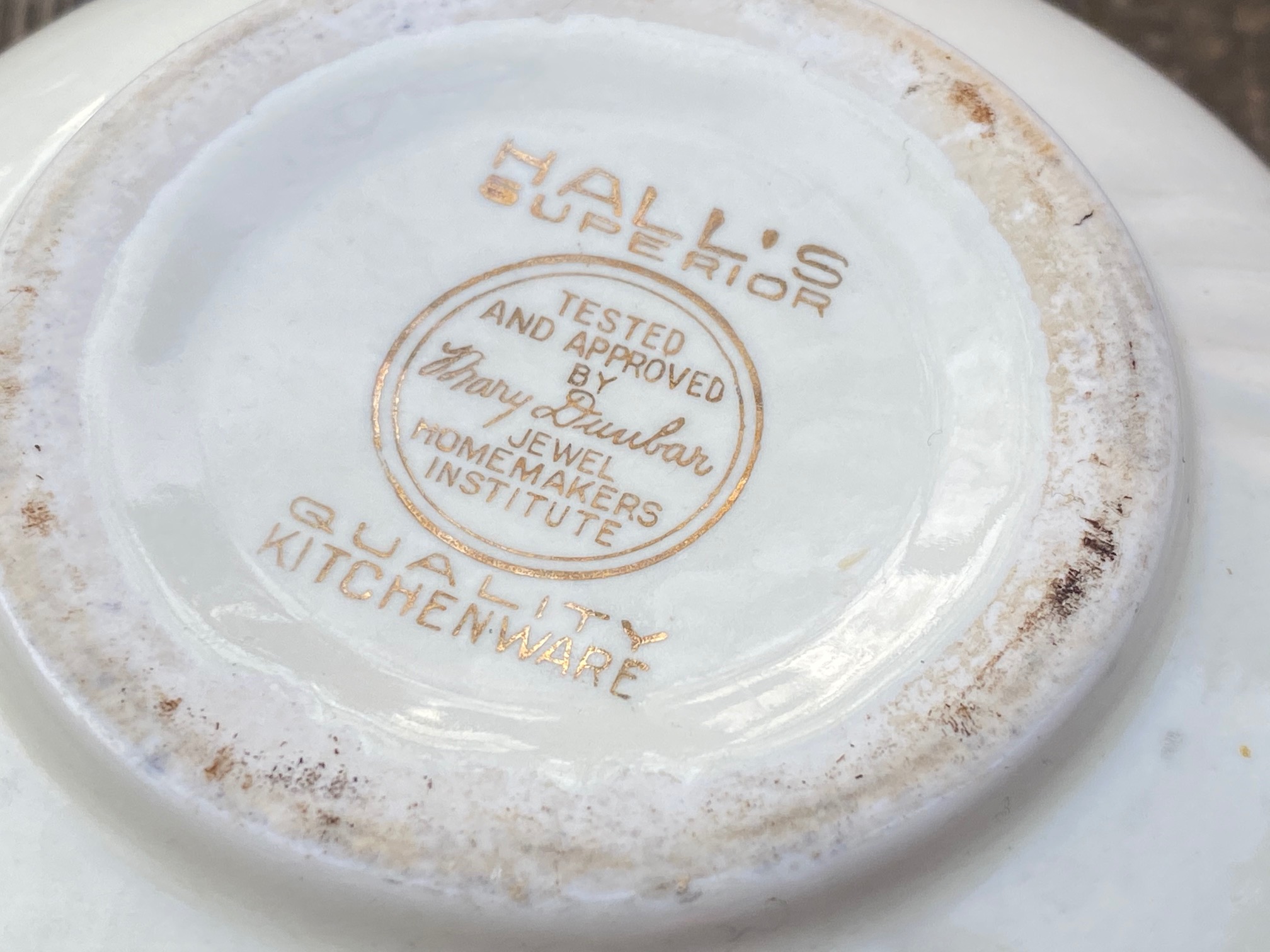
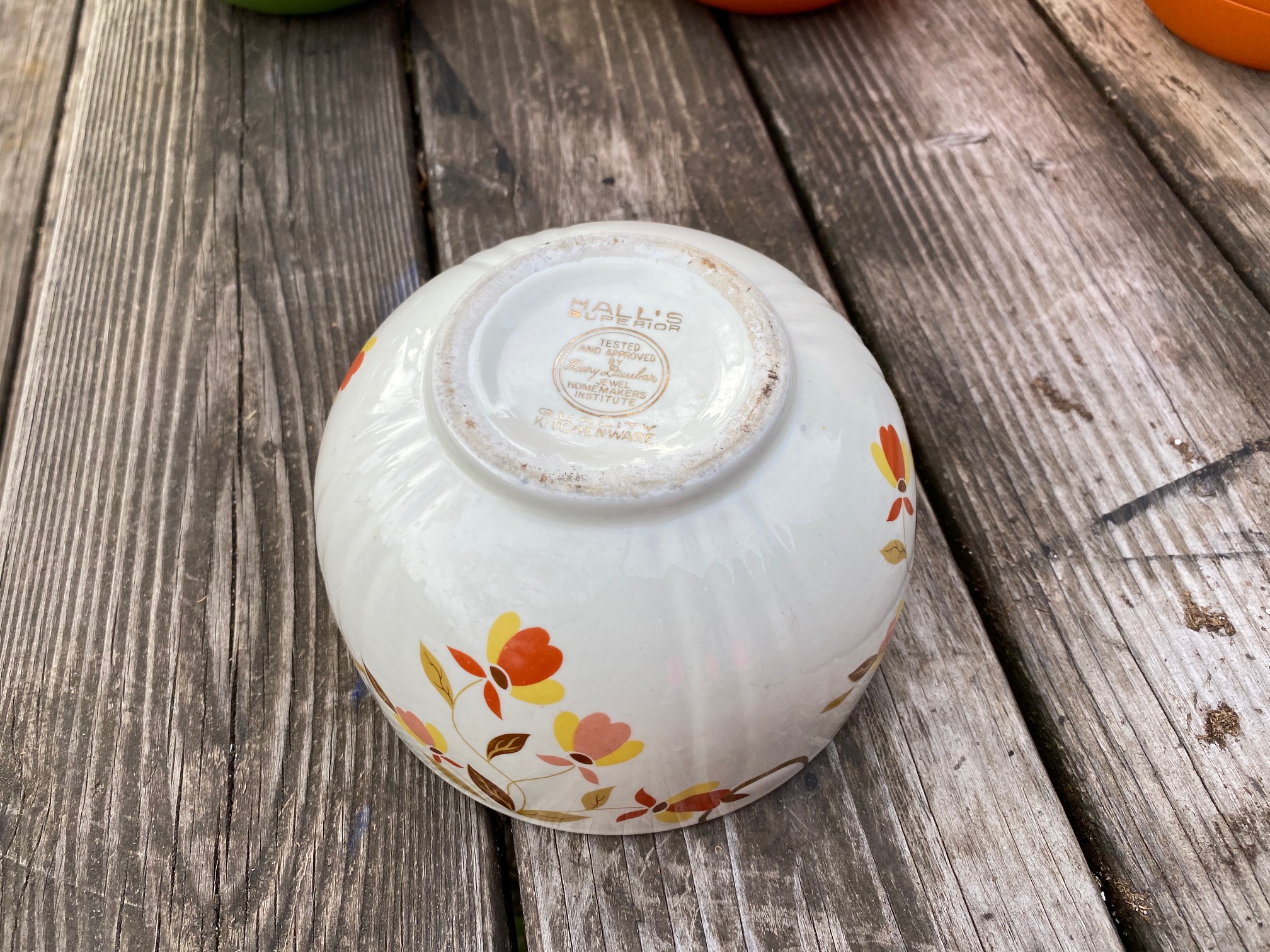
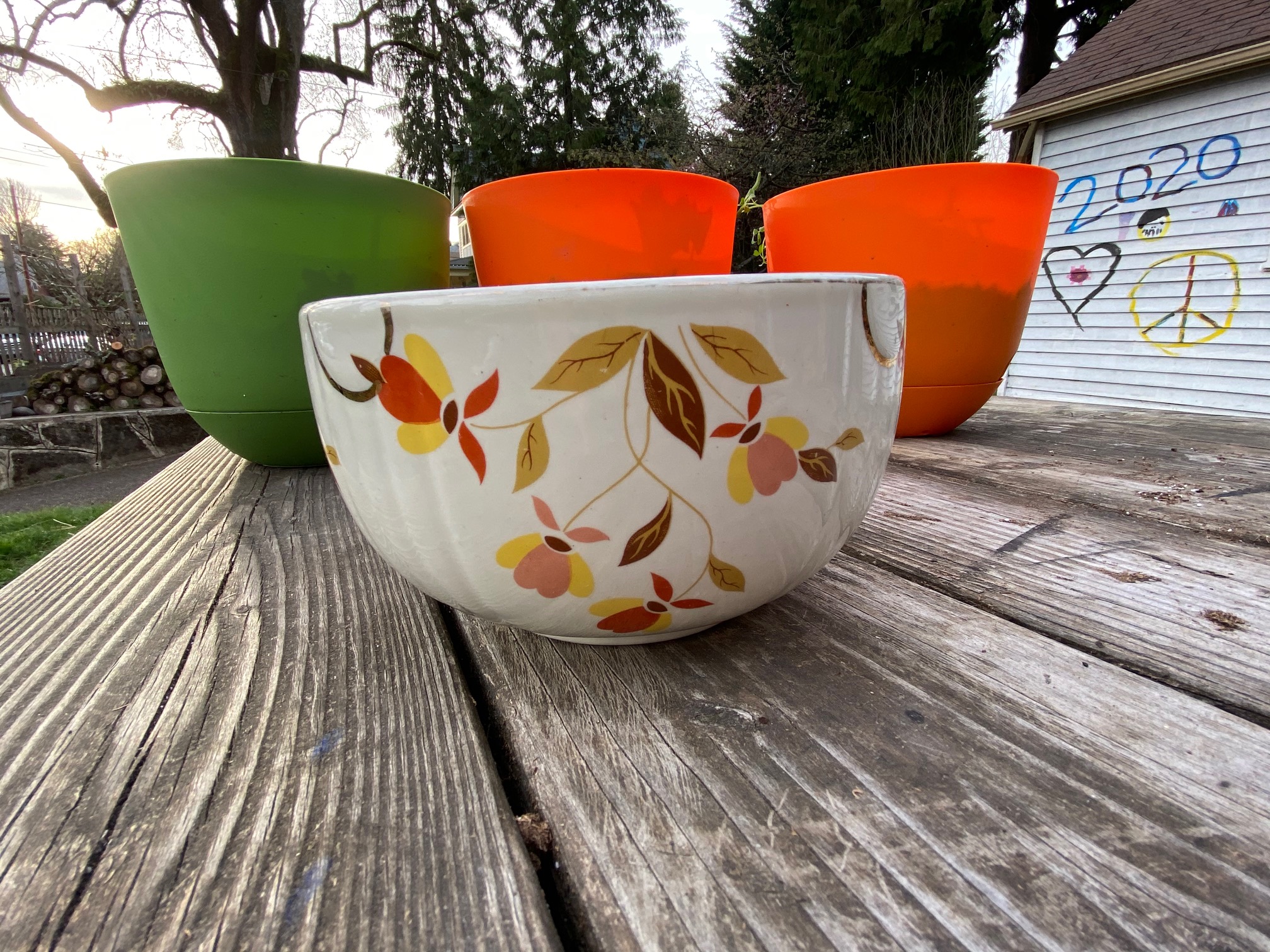

I have a bowl similar to this one also made by “Hall’s Superior Quality Kitchenware”, “Made in the U.S. A.” It was most probably a wedding gift to my mother in 1951. It’s very thick glass, dark cream to pale yellow in color with a few pink flowers around the bowl with a silver line also surrounding the top rim. It’s in perfect shape and I love it, but do not use it for food.
Such a shame we have to be worried about lead. I recently threw out the Tupperware measuring cups you posted as well as the matching measuring spoons. Tupperware should be sued…I bought a full kitchen of the stuff through the years, but never again! They have lost my trust. I just wish I knew this from the 1970’s and on. Thank you Tamara.
Thank you for commenting, Cheryl!
Tamara
I have this bowl, as well as a full 8-person service and various other items in this pattern – It’s called Autumn Leaf. (also “Jewel Tea Autumn Leaf”, in case you want to add to the search terms. My great grandmother collected much of it by drinking jewel tea and sending the box tops in, if you sent in so many box tops you would get a free cup, or saucer, or plate, etc.
My Mom inherited the set and added to it over the years from flea markets and antique stores… I inherited it from her about 7 years ago.
It was always “special event” dishwater so we rarely used it – just for display – but I’ve been planning to get it out and start using it. I have used the round French casserole once for rattatouie, but I guess I won’t be doing that again!
Sigh. Glad I found out now. But what do I do with 2 big plastic tubs of toxic dishware?
Your finding were very helpful. Was uncomfortable using but just couldn’t part with it. I had inherited my grandmothers Hall China Jewel Tea Autumn Leaf. Kept some out for decoration but was unsure if lead was part of the making of the dinnerware and it’s line of collections. I have occasionally in the past put food on the big serving platters. I’m not a collector but kept cause it’s a remembrance of my wonderful grandmother. I guess I need to sort and keep only for decoration and discard all the other pieces. In terms of bad lead using the scale of 0- 10 what does think rank?
Thank you, Annamarie
I came across this article while searching all Halls Kitchenware. I have the mixing bowl and casserole dish. I do use the casserole dish once in awhile. Is this article saying it’s unsafe to use due to lead levels.
I have two halls pots #648, i cooked rice in it, came out perfect, the second one I bought I heard ‘cracking ‘sound, maybe bec. I put in boiling water in it.
Is it dangerous to cook with these, and how do you cook with it, start with cold water then heat it up?
thank you, LIlly
I recently bought a set of these nesting bowls at an antique store. Are they safe to use or not?? I was planning on using the biggest one for my biscuit making bowl.
I am wondering what levels are unsafe? I have an antique Hall’s bowl that I have used for mixing not for cooking or serving. To be safe maybe I need to just get rid of it.
Hi Mary Beth. 90 ppm and up is regulated and considered to be unsafe in items manufactured for use by children. This standard is not applied to items intended for use by adults – but in my opinion it should be.
Tamara
I have the bowl. What is it’s value?
Hi Kimberly – I have no idea what the value is. In my book it is worth nothing given the high level of Lead found in the glaze.
Tamara
I agree with Tamara. Anything poisonous has zero value to me. That said please note this site is not about providing sales info. Stupidly I have been collecting mid century dishes since 2000 and eating from them. Dishes that cause us injury have zero value to me.
Hall China revised their ceramics with new colors and a new hallmark all between 1969 and 1970. Collectors have placed high value on the supposedly better quality made before 1970. Post 1969 Hall China has the square mark and is considered not desirable. Perhaps the reason 70 year old Hall China has become so cheap is people are discovering our lives have value above decor.
Thank you for commenting Susan!
hi Tamara-just tried to send a reply-don’t know if it went or??? I have the bowl pictured -never did hear about the lead the was in the glaze.i bought it @ a garage sale in Omaha in the sixties I am 92 now and have used it ever since.all our kids are healthy and I am as well.maybe this will bring a little to someone who might be worried about using the bowl??? Eieen
So, is Hall China made after 1969 lead free?
Probably not.
I have this bowl and love it and use it every day! Wouldn’t the lead portion be in the painted areas? And the gold leaf around the lid?… I’m not too worried about it since I don’t handle it every day all the time rubbing it around and around… Lol I just use a spoonful of sugar to help make the medicine (and food) go down!
If you don’t scrap off the glaze or paint and breath in or ingest, how is dishware with lead going to hurt you?
Maybe she’s talking about the heat that would be exposing the contaminants into the air into our lungs
Thank you for taking the time to do this testing. On several articles discussing the history of these dishes, it is said that Hall’s used a lead free glaze because of the high temperatures they were fired at. I am confused as to why these dishes have such high test results from a supposedly lead free glaze?!
I may be “the only person” not totally aware of what should NOT be cooked in, microwaved in, or even served in.
I have LONGABERGER plates, cups, and cereal serving bowls. I don’t use most of any of these often. Should I throw out all of them? I pay attention to what can and can’t be microwaved.
I separate my recycling per requested.
I have two of the “Superior Hall Quality” pieces.
One only used for decoration and the other I do serve in, but never cook in oven or microwave.
I bought Corelle dishes – but only the plain white that says microwaveable.
I appreciate your research and am forwarding your site to loved ones.
Thank you.
Franny
Hi Franny!
I just have this one Longaberger example (they didn’t test too poorly!):
https://tamararubin.com/2019/02/longaberger-pottery-vitrified-china-small-burgundy-plate-56-ppm-lead-101-ppm-cadmium/
Here’s the video that shows how to efficiently search the site too:
https://tamararubin.com/2022/05/how-to-use-the-lead-safe-mama-website-video/
Here’s the article discussing whether or not you might want to throw stuff out:
https://tamararubin.com/2019/12/what-should-i-do-with-my-lead-contaminated-dishes-to-toss-or-not-to-toss/
Tamara
I read an article (or two) that said Hall in East Liverpool, Ohio developed a lead free glaze in 1911 and began using it on kitchenware in 1914. I wonder if that was for inner surfaces only given your test results. Interesting. They are no longer an independent manufacturer; they were purchased by a company call ed Steelite I think. I wonder if they have information in their archives about how they used the lead less glaze and what that meant. I always find your information interesting. Sadly, I have collected a lot of antique dishes over the years. 🙁 if only there was reasonably priced testing available to the masses.
Hi. I can see where you have told us what level of lead is safe. The Hall bowl you test has the amount of lead but doesn’t tell us how much is safe. Please clarify. Thx.
I have some of this set and it does set off my geiger counter as being slightly radioactive:) probably the colored paint.
It’s shocking to see a kitchenware item with such a high lead content! I really appreciate the thorough testing by Mary Dunbar. It’s a reminder to all of us to be cautious and informed about the products we use in our homes. Thanks for shedding light on this issue!